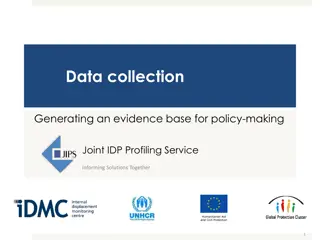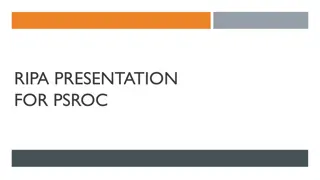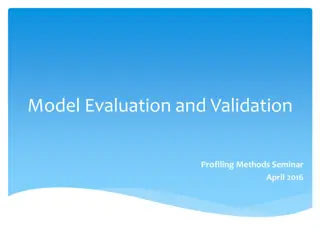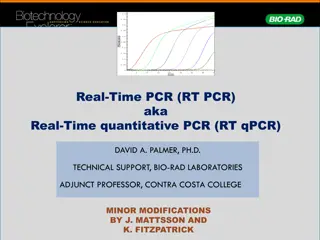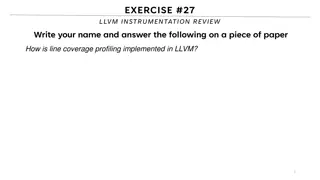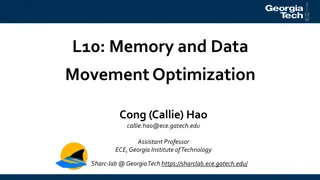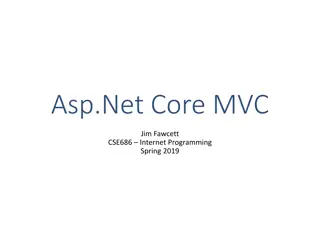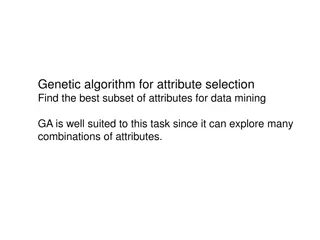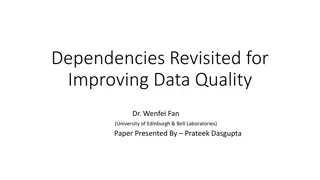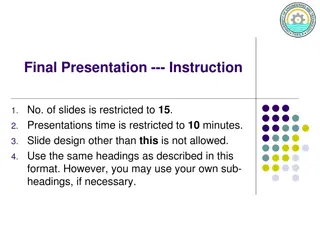Effective Data Selection Strategies for Model Building in Profiling Methods Seminar
Learn about the essential steps involved in selecting the right data for building effective models in the field of profiling methods. Understand the key considerations for data collection, formats, sample set determination, and targeting the right population to derive meaningful insights and outcomes.
Uploaded on Sep 24, 2024 | 0 Views
Download Presentation

Please find below an Image/Link to download the presentation.
The content on the website is provided AS IS for your information and personal use only. It may not be sold, licensed, or shared on other websites without obtaining consent from the author. Download presentation by click this link. If you encounter any issues during the download, it is possible that the publisher has removed the file from their server.
E N D
Presentation Transcript
STEP 1: Selecting Data for Model Building Profiling Methods Seminar April 2016
Data Collection What data do we need?
Data Collection Things to keep in mind: Data Availability Various State Data Sources Discriminatory Data (No sex, race, religion, etc.,) Personally Identifiable Data (PII) Variable Computations
Data Collection Cont. File format Based on your personal comfort level with data file manipulation and/or Statistical Software package being used. ASCII , CSV, TXT, XLS, XLM
Data Collection Cont. General Format of data Rectangular layout Rows = claimants Columns = variables Claimant ID Claim File Date WBA Potential Duration 64888 1/1/2014 350.00 26.0 67872 3/31/2014 355.00 26.0 76648 4/13/2014 290.00 18.0 78899 1/15/2014 250.00 16.0 89931 11/21/2013 355.00 26.0 64872 9/30/2013 340.00 24.0 48637 10/28/2013 355.00 26.0
Data Collection Cont. Determine Sample Set and Time Period Built on a Spine (SS number/Claimant ID ) Individuals with Valid, Payable Claims Use Benefit Year End Dates Example: BYE Dates covering the past 12 to 24 months
Targeted Population What is the Targeted Population? Valid Payable Claim Eligible for Referral More Recent Data Completed Benefit Year Minimum 12 Months (Multiple years useful for further analysis)
What Data Do We Need? Data Selection
What are we looking for? Data should describe the flow of the claimant Previous employment and background Benefit Eligibility Interactions with Workforce Development System Mandated/Voluntary Status Outcome of claim
What Kinds of Data to Use? UI characteristics and demographics taken with the initial claim UI benefit entitlement and benefits paid Details on any claimant interventions such as WPRS, REA, ERP, rapid response, etc. Data from workforce registration in the one stop Services provided to the claimant, whether mandatory or voluntary Actions taken against claimants who did not respond to a mandatory referral Wages reported to the state in the quarters after the claim became payable Any other known possible outcome data which might be of interest to the state such as NDNH, state employment records, etc.
UI Claims and Benefits Data Maximum Benefit Entitlement Total Benefits Paid Potential Duration Actual Duration WBA Date of Initial Claim (Benefit Year Begin and End Dates) Prior UI Experience? Referral to WPRS/REA/RESEA? Dependents allowance? Partial Claim? Separation Reason Claim type Inter-State Claim?
Claimant Characteristics and Indicators of Economic Climate Base Period Wages (Quarterly) Alternative Base Period Indicator Wage Replacement Rate High Quarter Wage Rate Separation Date Education Tenure (start & end dates with separating employer) Industry NAICS code of separating employer Job SOC/ONET code with separating employment State Unemployment Rates (total and/or insured) Number of Base Period Employers
More Variables to Consider County Designation (FIPS code) Local Office Designation Local Area Unemployment Rate (LAUS) * Indicator of severance/social security payments Number of years worked Household member employed? Prior UI Spells?/Number of Benefit Years established? # of Re-opens during Benefit Year Tenure in occupation Mass Layoff indicator Filing Method (Web, phone, in person) Child Support? Seasonal Job Indicator
UTs Model Variable Specification Categorical: Less than 12 years High School Diploma > 12 years and < 16 years > College Degree > Greater than 16 years Education Categorical: Less than 1 year >= 1 year and < 4 years >= 4 years and < 8 years >= 8 years and < 15 years >= 15 years Job Tenure
UTs Model (cont.) Variable Specification Categorical: 2 digit NAICS Code Industry Continuous Wage Replacement Ratio Continuous High Quarter Wage Rate Continuous: Days delayed Delay in Filing Categorical: 12 Months Month in year Categorical: 1/0 - yes/no Severance Status
Other Commonly Used and Recommended Variables Occupation: Categorical 2 Digit ONET/SOC + Additional Digits Where Applicable Unemployment Rate State Level TUR Local Areas (Metro/Regional/County) TUR Seasonally adjusted or non-seasonally adjusted*
Recommended Variables cont. Delay in filing for benefits in: Weeks Months Categorical Breakouts Education as a continuous variable Job tenure as a continuous variable Number of Base Period Employers Categorical Continuous
Key Calculated Variables cont. Wage Replacement Rate (WRR): ??? =?????? ??????? ?????? (???) ????? ???? ?????? ????? 52 Alternatively: W?? =?????? ??????? ?????? (???) ??? ??????? ????? 13
Key Calculated Variables Cont. High Quarter Wage Rate ??? ??????? ???? ?????? ????? ???? ?????? ????? ???? =
Further calculations to keep in mind Tenure = last day worked first day worked Delay in filing = file date last day worked Computed 2 digit Industry (NAICS) or Occupation (ONET-SOC) often need to be parsed out from the full 6 digit values
Additional Calculated Variables Exhaustion Rates in place of categorical variables Useful for variables with lots of categories such as NAICS codes and OCC codes Produce a crosstab of variable by exh Use the % of claimants in each category that exhausted Code that exhaustion rate as a new variable (i.e. if NAICS = 21 then compute NAICS_exh = 0.341 for 34.1%) Rates can be updated as new data becomes available Recommend using a lookup table for this
Example of a Crosstabulation of 2 Digit NAICS Codes versus Benefit Exhaustion The Percentage values in the highlighted column represent the exhaustion rates of each NAICS code group from this dataset. These can be recoded as a continuous exhaustion rate variable and used in the model.
Note: These exhaustion rates must be updated with each model update Additional updates of the exhaustion rates between broader model updates are also possible
Additional Calculated Variables Can also look at a continuously updated UI program exhaustion rate using ongoing claims data Number of Claimants that Exhausted Benefits in Month (t) Number of First Payments in Month(t-6) Or Number of Claimants that Exhaust in Months t thru t-5 Number of First Payments in Months t-6 thru t-11 (second formulation is a rolling, 6 month moving average, and smooths the exhaustion rate)
The Dependent Variable: UI Benefit Exhaustion
Defining an Exhaustee Standard Definition: A claimant that draws 100% of all available benefits Total $ Collected (Paid) = Total $ Entitled
Claimants by % of MBA Paid (AMT_PAID / MBA)
Exhaustion Rates (100% of Potential Benefits Paid) by Weeks of Potential Duration
Number of Claimants by Potential Duration
Variables in Utahs Model Education High Quarter Wage Rate Job Tenure Delay in Filing Industry Month of Year Wage Replacement Rate Severance
Model Scores Broken into 10 Equal Sized Groups Compared to the Average Potential Duration Based on the Utah Model Specs with 100% Benefit Exhaustion
Alternative Approaches to Modeling Long Term Unemployment Break out claimants into two separate models 1 w/ potential durations greater than or equal to 20 weeks 2 w/ potential durations of less than 20 weeks Determine an appropriate referral process from the two pools of claimants Use an alternative dependent variable (duration of actual unemployment spell would be the ideal variable)
Alternative Dependent Variables Define the dependent variable as claimants receiving >= X weeks of benefits Define dependent variable as claimants receiving X% or more of the states Maximum Total Benefit Amount Some alternate identifier of long term unemployment
Considerations When Modifying the Targeted Population Continuous Wage Replacement Rate Exh_1 = 100% of Potential Benefits Paid WRR Coefficient = 1.727 Exh_2 = 100% of Potential Benefits Paid AND Potential Duration >= 18 weeks WRR Coefficient = -3.244
Issues relating to use of an Alternate Dependent Problems related to identifying benefit exhaustees with potential durations below a certain threshold as non- exhaustees Effectively blocks shorter potential duration claimants from referral Inclusion of these claimants then creates misleading dynamics within model Weakens overall model performance Claimants exhausting short potential durations with other characteristics of desired target population skew model coefficients
Other Variations of the Dependent Variable Expand target to include claimants receiving at least some percentage of their total entitlement (i.e. claiming 90% of total entitlement instead of 100%) Broadens the profiling target population to include long duration claimants that might not necessarily be exhausting that could still benefit from RESEA and be able to return to work sooner OR find better employment with assistance
100% Benefit Exhaustion by Number of Years of Education
Alternate Dependent Variable by Number of Years of Education
Defining the Dependent/Target Population How you define your target population is up to you and your state Be aware of the issues with some alternative dependent variable definitions with relation to the logistical modeling process Legally must be based on expectations of identifying potential long- term unemployed claimants that will likely benefit from employment services Players in the decision can include RESEA Coordinator WPRS Coordinator Employment Services Representatives Others Decision should be made based on who the state feels would best be served by the employment services while fitting remaining within legal parameters of Section 303, SSA.



